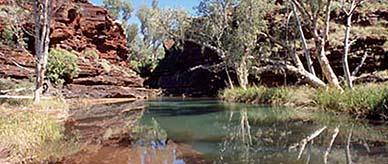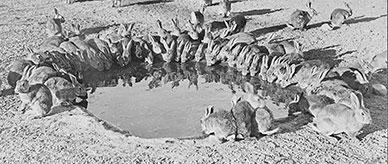
Transcript
Narrator: So the people of the valley wait on the thaw. The snow lies deep on the mountains and high plains – storing up millions of gallons of water until, one morning in early spring …
[MUSIC INTERLUDE]
The snow and the water racing down make creeks in the gullies of the timbered hills, make streams in the valleys of the mountains. They run down the Dargals, the Spur and the Razorback. They run down from Feathertop, Townsend and Bogong. They run through the ash at the pine of Tumbarumba.
[MUSIC INTERLUDE]
Down from the mountains into the valley, down the Indi, down the Swampy, down the slopes to Bringenbrong Bridge to make a river – the Murray that flows 1,600 miles to the sea and makes the Murray Valley.
[MUSIC INTERLUDE]
Down through the Murray River Valley it lumbers, down past Towong, Jingellic and Granya, gathering the waters of the Mitta and the Kiewa, swelling its stream. Then into the Hume Weir to spill over the paddocks of the storage and flood back into the hills.
[RUSHING WATER]
Then to the lowlands, gathering the Ovens, on to Lake Mulwala and Yarrawonga Weir. On to Torrumbarry, Euston, Echuca, gathering the Loddon, the Goulburn, Campaspe, gathering the Murrumbidgee from Gundagai and Wagga, gathering the Lachlan from Condobolin and Booligal. Gathering the Darling from Bourke and Menindee, fed by the Warrego, Paroo and Castlereagh.
[MUSIC INTERLUDE]
[END]
About this record
This clip, from the black-and-white documentary The valley is ours, traces the path of the Murray River from its origins in the Snowy Mountains down into the Murray Valley and across Victoria to South Australia. It was made by the Commonwealth Film Unit for the Australian National Film Board, directed by John Heyer and produced by Stanley Hawes, a pioneer Australian documentary filmmaker, the head of the Commonwealth Film Unit and the first Producer-in-Chief of the Australian National Film Board.
Educational value
- The valley is ours is a tribute to Australia's longest river system, the Murray, and this clip suggests some of the ways in which the Murray sustains life, land and townships along its westward 2,575-kilometre path to the Great Australian Bight. The film tracks the major tributaries gathered by the Murray from its source in the Snowy Mountains through to its main feeding rivers, the Darling and Murrumbidgee. It also shows major weirs and dams, and towns supported by the river, including Echuca and Mildura.
- The central theme of the film, released the year before work began on the Snowy Mountains Hydro-Electric Scheme, is the harnessing of a river to meet the needs of the Australian population. The filmmakers intended in part to promote the progress made by Australia after the Second World War. Sections of the film not shown here celebrate the lives of people as they overcome erosion, bushfire and drought, and the farming, fishing, mining and shipping communities dependent on the Murray in New South Wales, South Australia and Victoria.
- The clip represents a tradition of lyrical documentary filmmaking. It includes dramatised scenes, evocative music, artistic cinematography and poetic narration that echoes the rhythm and movement of the river itself. Beautifully composed shots show ripples of water in a mountain pool and large chunks of snow falling into the river and floating downstream. Tracking shots mirror the rhythm and flow of the River’s path. In making the film, Heyer drew on The river (1936), Pare Lorentz’s celebrated documentary homage to the Mississippi River.
- Paddle-steamers, such as the ones shown in this clip, were the basis of an extensive transport system on the Murray–Darling River from the mid-1800s to the early 1900s. The steamers serviced inland settlements and helped to develop agricultural industries. They used the rivers as highways, carrying passengers and supplies such as wool and wheat. Inland ports, including Goolwa, Swan Hill and Echuca, developed to facilitate tourism and trade.
- The valley is ours was produced by the Commonwealth Film Unit (also known as the Film Division), the production agency of the Australian National Film Board. The Unit operated from 1940 to 1973, creating films that promoted Australia as a trading nation and an attractive destination for migration. Unit films were screened on television and shown by Australian embassies overseas.
- John Heyer (1916–2001), one of Australia's most influential filmmakers, is remembered for his lyrical, literate and nationalistic documentaries. Heyer worked with some of Australia’s leading filmmakers before beginning a short but productive association with the Australian National Film Board (later Screen Australia) as a senior producer in 1945. Heyer left the Board in 1948 to form the Shell Film Unit (Australia) and in 1954 made the outback documentary masterpiece The back of beyond, set along the Birdsville Track.
Acknowledgments
Learning resource text © Education Services Australia Limited and the National Archives of Australia 2010.
Related themes
Need help with your research?
Learn how to interpret primary sources, use our collection and more.


